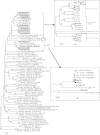Detection and genetic diversity of porcine group A rotaviruses in historic (2004) and recent (2011 and 2012) swine fecal samples in Ohio: predominance of the G9P[13] genotype in nursing piglets
- PMID: 23363823
- PMCID: PMC3666770
- DOI: 10.1128/JCM.03193-12
Detection and genetic diversity of porcine group A rotaviruses in historic (2004) and recent (2011 and 2012) swine fecal samples in Ohio: predominance of the G9P[13] genotype in nursing piglets
Abstract
Epidemiological surveillance of porcine group A rotavirus (RVA) strains was conducted in five swine herds in Ohio using historical (2004) and recent (2011 to 2012) fecal samples. Of the 371 samples examined, 9.4% (35/371) were positive for RVA. The RVA detection rates increased from 5.9% in 2004 and 8.5% in 2011 to 13.8% in 2012. A total of 23 positive samples were analyzed for RVA G and P genotypes. The dominant G-P combination was G9P[13] found in 60.9% of positive samples. The other combinations were G9P[7] (8.7%), G4P[13] (8.7%), G11P[13] (4.3%), and G11P[7] (4.3%). Sequence analysis of partial VP7 genes of selected strains revealed that the G4 strains were closely related to one another (95%) and, to a lesser extent, to human (82 to 84%) and porcine (84 to 86%) G4 strains. The G11 strains detected shared identical VP7 gene sequences (100%) and were closely related to human (85 to 86%) and other porcine (83%) G11 strains. The G9 strains identified were closely related to one another and to human and other porcine strains (96 to 97%, 89 to 91%, and 89 to 91% nucleotide identities, respectively). The VP4 gene analysis revealed that P[7] strains were closely related to each other and to P[7] strains isolated from porcine, bovine, and panda samples (91 to 99%, 92 to 99% and 92 to 99%, respectively). The P[13] strains showed a higher diversity among themselves and with other porcine P[13] strains, ranging from 83% to 99% and from 82 to 97%, respectively. Our results demonstrate broad genetic heterogeneity of the RVA strains and suggest the possibility of genetic reassortment between different RVA genotypes within these farms.
Figures


References
-
- Katsuda K, Kohmoto M, Kawashima K, Tsunemitsu H. 2006. Frequency of enteropathogen detection in suckling and weaned pigs with diarrhea in Japan. J. Vet. Diagn. Invest. 18:350–354 - PubMed
-
- Chang K, Kim Y, Saif LJ. 2012. Rotavirus and reovirus, p 621–634 In Zimmerman JJ, Karriker LA, Ramirez A, Schwartz KJ, Stevenson GW. (ed), Diseases of swine, 10th ed Wiley-Blackwell, United Kingdom
-
- Collins PJ, Martella V, Sleator RD, Fanning S, O'Shea H. 2010. Detection and characterisation of group A rotavirus in asymptomatic piglets in southern Ireland. Arch. Virol. 155:1247–1259 - PubMed
-
- Estes MK, Kapikian AZ. 2007. Rotaviruses and their replication, p 1917–1974 In Knipe DM, Howley PM, Griffin DE, Lamb RA, Martin MA, Roizman B, Straus SE. (ed), Fields virology, 5th ed Lippincott Williams & Wilkins, Philadelphia, PA.
-
- Kapikian AZ. 2001A rotavirus vaccine for prevention of severe diarrhoea of infants and young children: development, utilization and withdrawal. Novartis Found. Symp. 238:153–179 - PubMed
Publication types
MeSH terms
Substances
Grants and funding
LinkOut - more resources
Full Text Sources
Other Literature Sources
Medical

